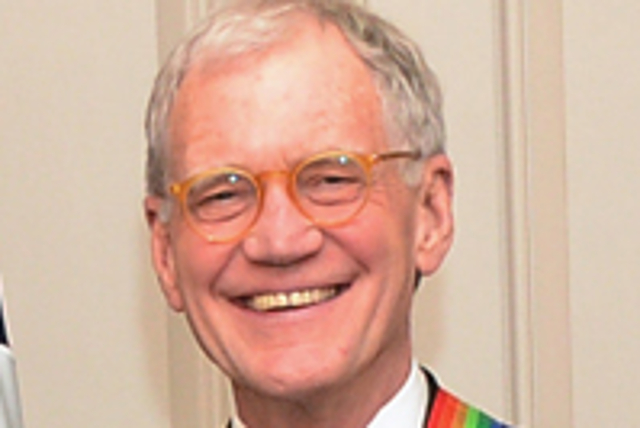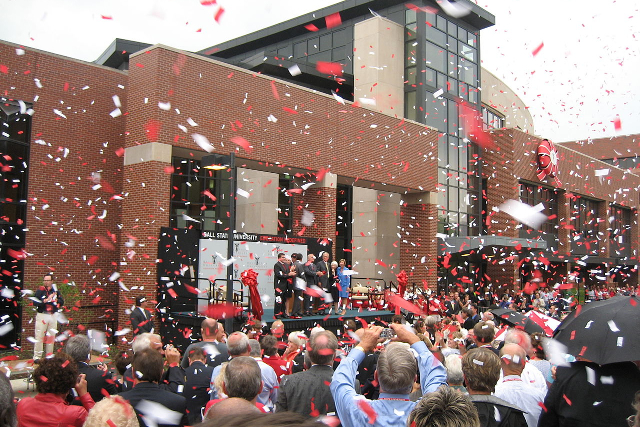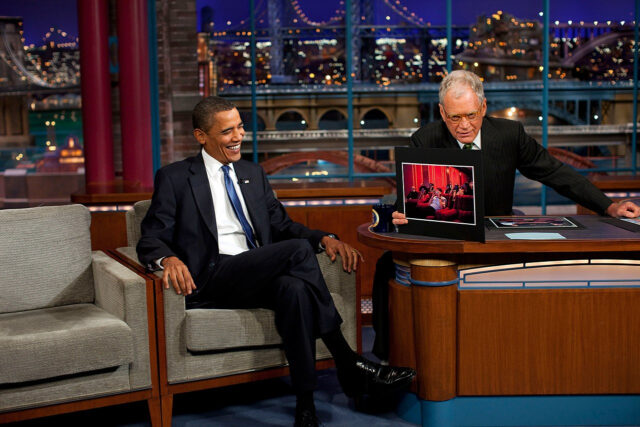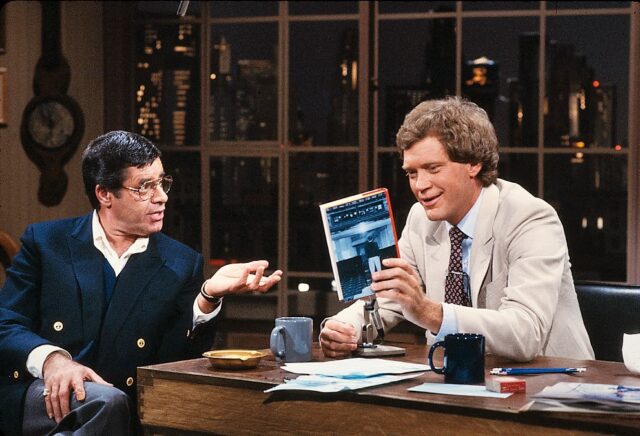David Letterman first gained national attention as a comedian through appearances on The Tonight Show Starring Johnny Carson. By 1980, his growing fame and somewhat different approach to comedy encouraged NBC to offer him his own show. Letterman remained with NBC until he was denied his opportunity to take over the Tonight Show upon Carson’s 1992 retirement. Instead, he left his show, Late Night with David Letterman and went to CBS, creating The Late Show with David Letterman.
He took with him an element of his weeknight program, created by his staff of writers: the nightly Top Ten List, allegedly created in a fictional home office in varying locales. From its introduction on Late Night, Letterman’s nightly lists were wildly popular and stemmed imitations and variations around the country. The popular format remains widely imitated today. Letterman popularized the format, and continued to use it five nights a week until he retired from The Late Show, the last broadcast of which occurred on May 20, 2015. Here are 10 facts about David Letterman.
10. Several elements of his programs were inspired by a regional talk show he watched as a youth

David Letterman grew up in Indianapolis, Indiana. His midwestern youth included working as a stocker-bag boy in a local supermarket, the Atlas Supermarket in the Kessler neighborhood. It also included entertainment on television offered by the Cincinnati based Crosley (later Avco) Broadcasting System. The network broadcast daytime talk and entertainment programs from its Cincinnati studios to affiliates in Columbus and Dayton, Ohio, as well as Indianapolis (WLWI, Channel 13). On occasion the programs were broadcast from outside the Cincinnati studios, such as from the Ohio State Fair in Columbus, or from Indianapolis.
Among the programs Letterman watched, often with his mother, was The Paul Dixon Show, a morning program originally half an hour long, though later expanded to 90 minutes. The show was mainly Dixon interacting with his audience, mostly housewives, mugging from his desk, and performing mostly live commercials. The entire program was live, with the exception of a few prerecorded bits from time to time.
Dixon awarded members of his audience a kosher salami after interviewing them, an act later mimicked by Letterman when he gave audience members canned hams, or boxes of meat. Dixon frequently referred to his own program as “this dumb show”, another bit of schtick Letterman routinely used. Letterman often acknowledged his debt to The Paul Dixon Show, going so far as to credit the program with influencing his choice of career.
9. His feud with Oprah Winfrey was on again, off again, and on again
Letterman’s feud with Oprah Winfrey was both real and playacting, depending on the date and the sources involved. Oprah said it began after an appearance by her on Letterman’s show, during which his interviewing technique made her uncomfortable. Letterman told interviewers the feud began several years later, when he stuck Oprah with the check for himself and his girlfriend’s lunch.
In 1995 Letterman hosted the Academy Awards, where he made several jokes at Oprah’s expense, and in the 1990s she was a frequent target of his jibes during his monologues. Oprah later told TIME Magazine that she was uncomfortable being the butt of his jokes, and thus had no interest in appearing on his show. Both Letterman and Oprah used the “feud” for publicity purposes.
The feud was declared over when Oprah agreed to appear on Letterman in December, 2005, as part of the publicity campaign for the stage production of The Color Purple, which Oprah produced on Broadway. However, both stars continued to use it for publicity purposes, as did CBS.
8. He created a scholarship at Ball State University for the benefit of “just average” students, as he claimed he was

David Letterman graduated from Ball State University in Muncie, Indiana, where he was by his own admission just an average student, as measured by GPA. So, when he endowed a scholarship at Ball State he mandated that its award would not be based on grades or needs. Instead the scholarship, open to telecommunications students, is based on creativity.
Noting his own grades were such that few scholarships were available to him, Letterman created his scholarship with his own situation in mind. Students applying for the scholarship must submit a creative project for consideration. The scholarship is actually awarded to three students, the winner and a first and second runner-up. Letterman first sponsored the scholarship in 1985.
In 2022, through his motor racing partnership, Rahal Letterman Lanigan Racing, another scholarship was announced in support of Ball State’s Esports Program. The scholarship is scheduled to be awarded to two Ball State student-athletes each year through the 2025-26 academic year.
7. His television career began as a weatherman in Indianapolis, Indiana
Letterman graduated from Ball State in 1969, after which he began a radio talk show in Indianapolis, and served as a weatherman on WLWI (later changed to WTHR). As a presenter rather than a trained meteorologist, his weather broadcasts were often irreverent, as he focused on entertainment value rather than a simple recitation of weather events and forecasts.
He once reported a tropical storm being upgraded to a hurricane by congratulating it on its promotion. He predicted hailstones in an upcoming storm could be “the size of canned hams” and invented the names of towns and the amount of precipitation they received.
When a satellite map failed to present the border between Indiana and Ohio, he attributed the absence to political shenanigans. He mumbled about it being a plot instigated by local and state authorities, over which he had no control. Besides doing the weather, he hosted a children’s program, and a Saturday morning talk show, called Clover Power, in which he interviewed 4-H members. As the host of a late night movie program called Freeze Dried Movies, he once acted out scenes from Godzilla using plastic dinosaur models.
6. He auditioned for the lead role in the comedy film Airplane! as well as appearing in several game shows

In 1975 Letterman and his first wife, Michelle, relocated to Los Angeles. He began appearing regularly at the Comedy Store, performing standup routines, and working as a writer for comedian Jimmy Walker. In that role he was joined by later rival Jay Leno, as well as several other comedians. He hosted a game show pilot, which failed to be produced, and appeared in several game shows on programs which were. Among them were Hollywood Squares, The Gong Show, and Liar’s Club.
In 1980 he auditioned for the film Airplane!, receiving a screen test for the role later taken by Robert Hays. The role was the lead for the film, a former military pilot with a “drinking problem”, Ted Stryker. The “drinking problem” referred to his inability to hit his mouth with a glass, instead throwing the beverage into his own face. The film became a smash hit both with audiences and critics, but beyond the screen test Letterman wasn’t involved with the project.
Though he appeared in several sitcoms in a guest role, Letterman failed to gain much success as an actor throughout the 1970s. His work in standup did gain attention and eventually those noticing him included Johnny Carson, then host of The Tonight Show. Letterman’s first appearance on Carson’s program occurred in November, 1978. He would appear on the program as a guest more than 20 times over the next few years.
5. His first nationally broadcast show was a daytime talk show similar to those he watched years earlier
In 1980 NBC’s morning lineup, following the venerable Today Show, consisted of six game shows spanning three hours of broadcast time. By then, Letterman had made numerous appearances on The Tonight Show, including as a guest host. With a relationship with NBC thus established, studio executives decided to give Letterman his own show, a morning talk show. To gain room in the schedule, three game shows were canceled, including the long-running daytime version of Hollywood Squares.
Originally, The David Letterman Show ran for 90 minutes. Its first broadcast took place on June 23, 1980. An immediate success with critics, it struggled to find an audience. It was during the run of the show that Letterman introduced many of the sketches and skits which gained fame in his later shows, including Stupid Pet Tricks. Nonetheless, ratings foundered and in August the show was cut to one hour.
In October NBC announced the show would be canceled, its last broadcast on October 24. For the final three weeks of the show Letterman pulled out the stops. He held a contest to have the show held in a private home; he produced a taped segment in a home in Cresco, Iowa. After the cancellation, NBC paid Letterman $1 million to remain under contract, protection against losing his services to another network or syndication.
4. His staff at Late Night with David Letterman based the Top Ten List on eligible bachelor lists of the day
Late Night with David Letterman premiered on NBC on February 1, 1982, immediately following Johnny Carson’s Tonight Show. Unlike Carson, who broadcast his show from Burbank, California, Letterman chose to use New York as his base, taping his show in NBC’s Studio 6A. Among the staff hired by Letterman for his show was Head Writer Steve O’Donnell.
O’Donnell later claimed the idea of the Top Ten List sprang up in the minds of several staff writers simultaneously, inspired by the most eligible bachelors lists then printed in newspaper society pages. It quickly became a centerpiece of the nightly broadcasts, usually delivered by Letterman, but on occasion by members of the staff, surprise guests, and taped celebrities.
The Top Ten List went with Letterman when he abandoned NBC for CBS, though he was forced to change its name briefly. By then its popularity was such that newspaper and magazine columnists, sportswriters, entertainers, and broadcasters adapted its format, using a top ten list to cover stories virtually unlimited in scope.
3. NBC tried to block Letterman from using the Top Ten List when he changed networks after Johnny Carson retired

When Johnny Carson announced his retirement it was widely assumed that David Letterman would be his successor at The Tonight Show. When he was not, the chair going to Jay Leno, Letterman decided to take his show to rival network CBS, in a time slot which directly competed with Leno. NBC, angry at losing Letterman and concerned about the competition, tried to block Letterman from using several of the sketches developed on Late Night.
Among them was the Top Ten List. NBC claimed the list, both name and format, was the intellectual property of the network. It made similar claims for other staples of the show, including some of those created for the earlier daytime show. Letterman countered the Top Ten List couldn’t be the network’s property, since the idea had been stolen from other sources.
2. He hosted the Academy Awards and drew heavy criticism that he trivialized the event
David Letterman served as the master of ceremonies for the Academy Awards, commonly called the Oscars, in 1995. As part of the broadcast he presented a Top Ten List: Top Ten Signs The Movie You Are Watching Will Not Win An Academy Award. His announcement of the list drew one of the loudest rounds of applause he received all evening.
The rest of the evening was not so well received, not by his live audience, the television audience, or critics. He later referred to his performance at the event as an “explosion of excrement”. One joke, which caused eyes to roll and audible groans from the audience added to the feud with Oprah Winfrey. Letterman used the disastrous outing as fodder for self-deprecating jokes for several years.
It was long believed that Letterman’s performance at the Oscars prevented the Academy from ever asking him to host again. In fact, Letterman was asked to return as host, though he declined.
1. Johnny Carson’s last appearance on television was to deliver a Top Ten list on Letterman’s show
On May 13, 1994, David Letterman announced the Top Ten List was being delivered by Johnny Carson. As the band played The Tonight Show theme, Bud Melman (Calvert DeForest) carried the list to Letterman. After the apparent joke on the audience was over, Letterman noticed the card he’d received did not contain the list for the evening and called for it again.
This time Johnny Carson came out, delivering the list to Letterman amidst raucous applause from the standing audience. Carson exchanged a few words with Letterman, briefly sat at his desk, acknowledged the applause several times, and after shaking his head and saying, “no, no, no…” left the stage. Carson had appeared on Letterman’s show to be interviewed before, though never on the program hosted by Jay Leno.
Letterman’s show had been broadcasting from Los Angeles that week, which allowed Carson to appear on the show, and the appearance had been planned in advance. Whether Letterman hoped he would stay for conversation is unknown. But Letterman long revered Carson as both a friend and mentor, often saying he owed his career to the former Tonight Show star. The brief visit was Johnny Carson’s last appearance on television. He died in January, 2005.